tire pressure Lexus ES300h 2019 (OM33E25U) User Guide
[x] Cancel search | Manufacturer: LEXUS, Model Year: 2019, Model line: ES300h, Model: Lexus ES300h 2019Pages: 456, PDF Size: 9.62 MB
Page 242 of 456
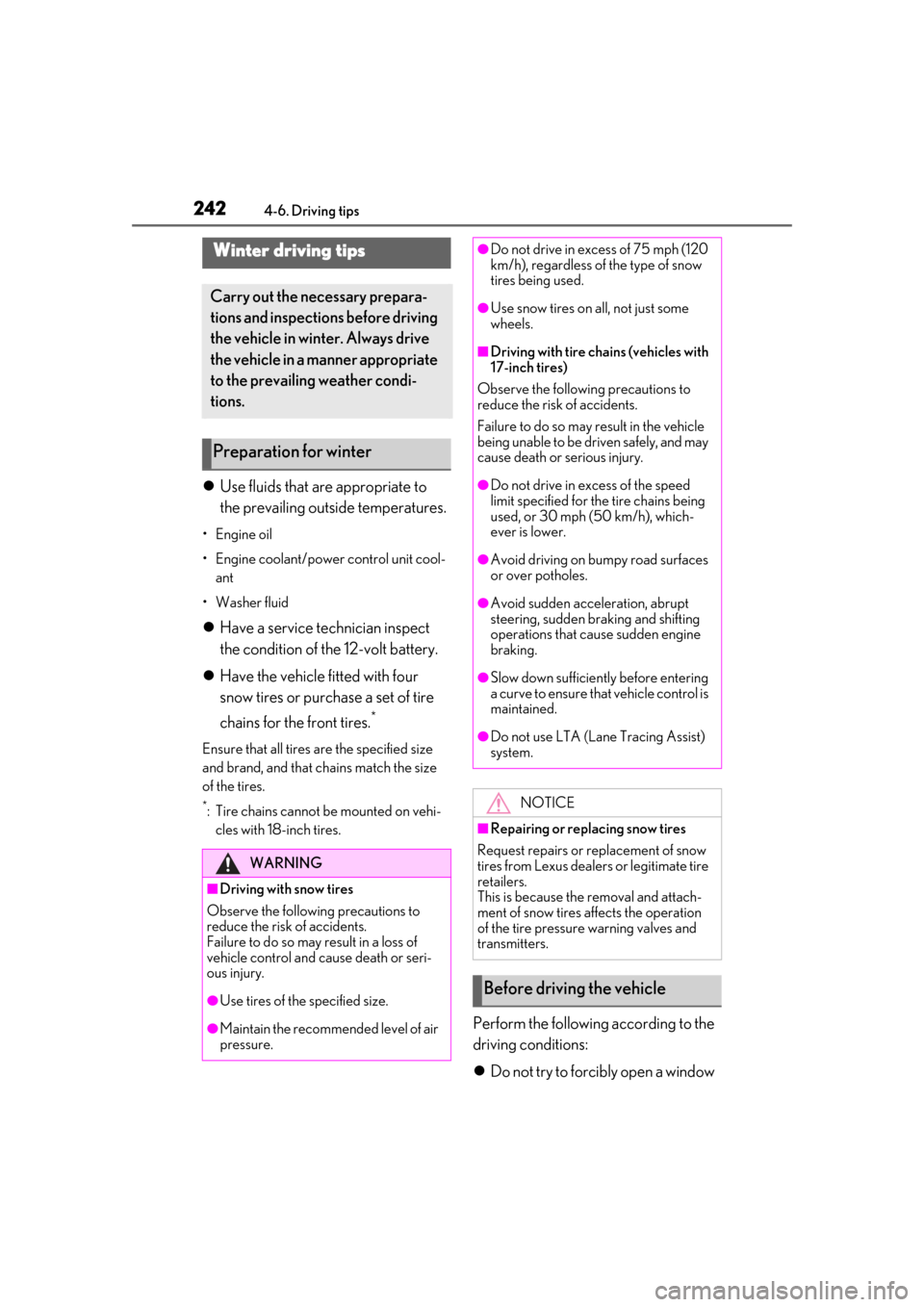
2424-6. Driving tips
ΎΒυUse fluids that are appropriate to
the prevailing outside temperatures.
έΑλ Engine oil
έΑλ Engine coolant/power control unit cool-
ant
έΑλ Washer fluid
ΎΒυ Have a service technician inspect
the condition of the 12-volt battery.
ΎΒυ Have the vehicle fitted with four
snow tires or purchase a set of tire
chains for the front tires.
*
Ensure that all tires are the specified size
and brand, and that chains match the size
of the tires.
*: Tire chains cannot be mounted on vehi-
cles with 18-inch tires.
Perform the following according to the
driving conditions:
ΎΒυ Do not try to forcibly open a window
Winter driving tips
Carry out the necessary prepara-
tions and inspections before driving
the vehicle in winter. Always drive
the vehicle in a manner appropriate
to the prevailing weather condi-
tions.
Preparation for winter
WARNING
έΨιDriving with snow tires
Observe the following precautions to
reduce the risk of accidents.
Failure to do so may result in a loss of
vehicle control and cause death or seri-
ous injury.
έΩΠUse tires of the specified size.
έΩΠMaintain the recommended level of air
pressure.
έΩΠDo not drive in excess of 75 mph (120
km/h), regardless of the type of snow
tires being used.
έΩΠUse snow tires on all, not just some
wheels.
έΨιDriving with tire chains (vehicles with
17-inch tires)
Observe the following precautions to
reduce the risk of accidents.
Failure to do so may result in the vehicle
being unable to be driven safely, and may
cause death or serious injury.
έΩΠDo not drive in excess of the speed
limit specified for the tire chains being
used, or 30 mph (50 km/h), which-
ever is lower.
έΩΠAvoid driving on bumpy road surfaces
or over potholes.
έΩΠAvoid sudden acceleration, abrupt
steering, sudden br aking and shifting
operations that cause sudden engine
braking.
έΩΠSlow down sufficiently before entering
a curve to ensure that vehicle control is
maintained.
έΩΠDo not use LTA (Lane Tracing Assist)
system.
NOTICE
έΨιRepairing or replacing snow tires
Request repairs or replacement of snow
tires from Lexus dealers or legitimate tire
retailers.
This is because the removal and attach-
ment of snow tires affects the operation
of the tire pressure warning valves and
transmitters.
Before driving the vehicle
Page 244 of 456
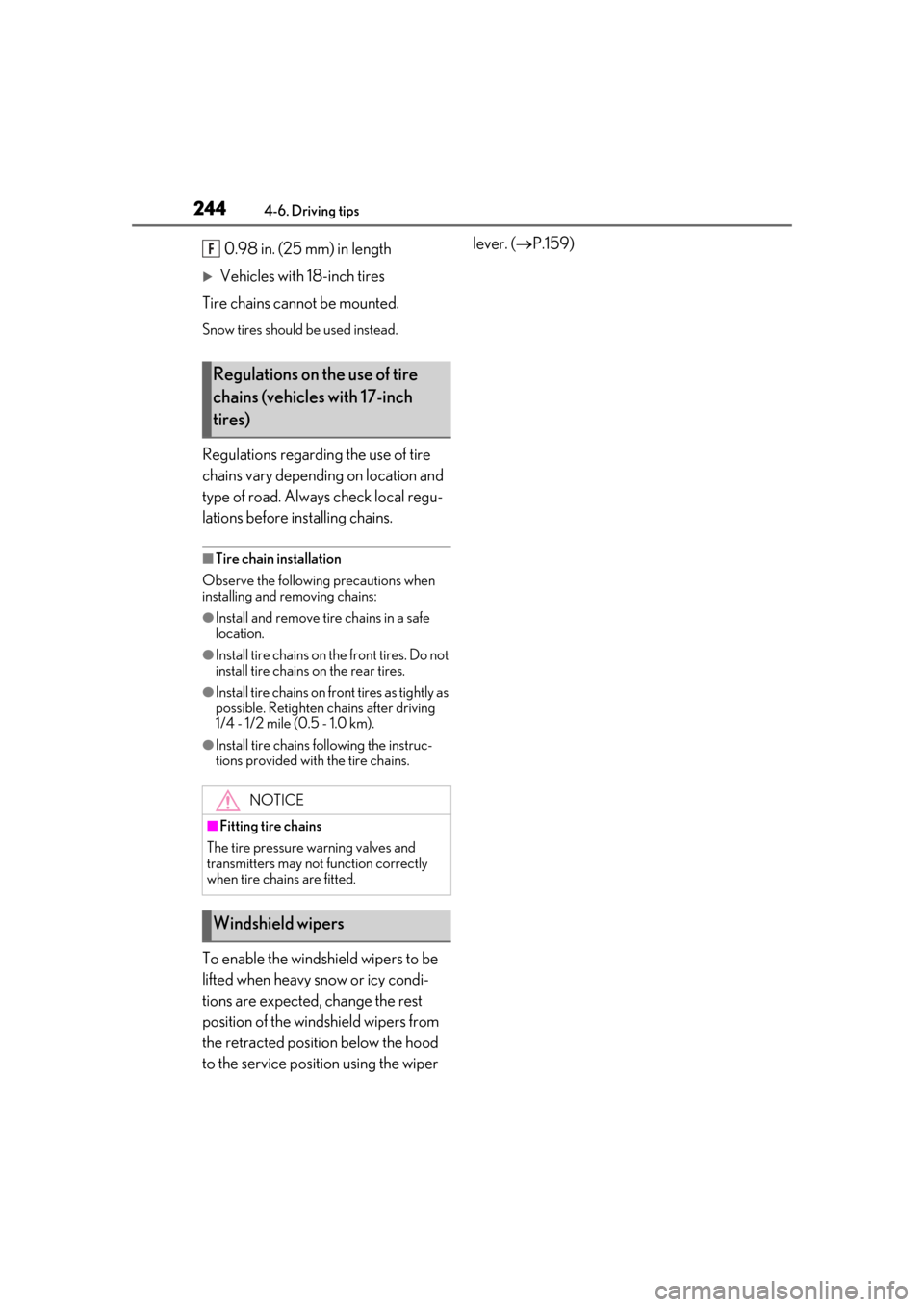
2444-6. Driving tips
0.98 in. (25 mm) in length
ΎΒ╡Vehicles with 18-inch tires
Tire chains cannot be mounted.
Snow tires should be used instead.
Regulations regarding the use of tire
chains vary depending on location and
type of road. Always check local regu-
lations before installing chains.
έΨιTire chain installation
Observe the following precautions when
installing and removing chains:
έΩΠInstall and remove tire chains in a safe
location.
έΩΠInstall tire chains on the front tires. Do not
install tire chains on the rear tires.
έΩΠInstall tire chains on fr ont tires as tightly as
possible. Retighten chains after driving
1/4 - 1/2 mile (0.5 - 1.0 km).
έΩΠInstall tire chains following the instruc-
tions provided with the tire chains.
To enable the windshield wipers to be
lifted when heavy snow or icy condi-
tions are expected, change the rest
position of the windshield wipers from
the retracted position below the hood
to the service position using the wiper lever. (
ΎΓχP.159)
Regulations on the use of tire
chains (vehicles with 17-inch
tires)
NOTICE
έΨιFitting tire chains
The tire pressure warning valves and
transmitters may not function correctly
when tire chains are fitted.
Windshield wipers
F
Page 299 of 456

299
6
6
Maintenance and care
Maintenance and care
6-1. Maintenance and careCleaning and protecting the vehi-cle exterior ................................ 300
Cleaning and protecting the vehi- cle interior ................................. 303
6-2. Maintenance Maintenance requirements .. 309
General maintenance .............. 310
Emission inspection and mainte- nance (I/M) programs .......... 313
6-3. Do-it-yourself maintenance Do-it-yourself service precautions......................................................... 314
Hood................................................ 316
Positioning a floor jack............. 316
Engine compartment................ 318
12-volt battery............................. 323
Tires ................................................ 326
Tire inflation pressure .............. 334
Wheels........................................... 336
Air conditioning filter...............338
Electronic key battery ............. 339
Checking and replacing fuses 341
Headlight aim.............................. 343
Light bulbs .................................... 344
Page 312 of 456
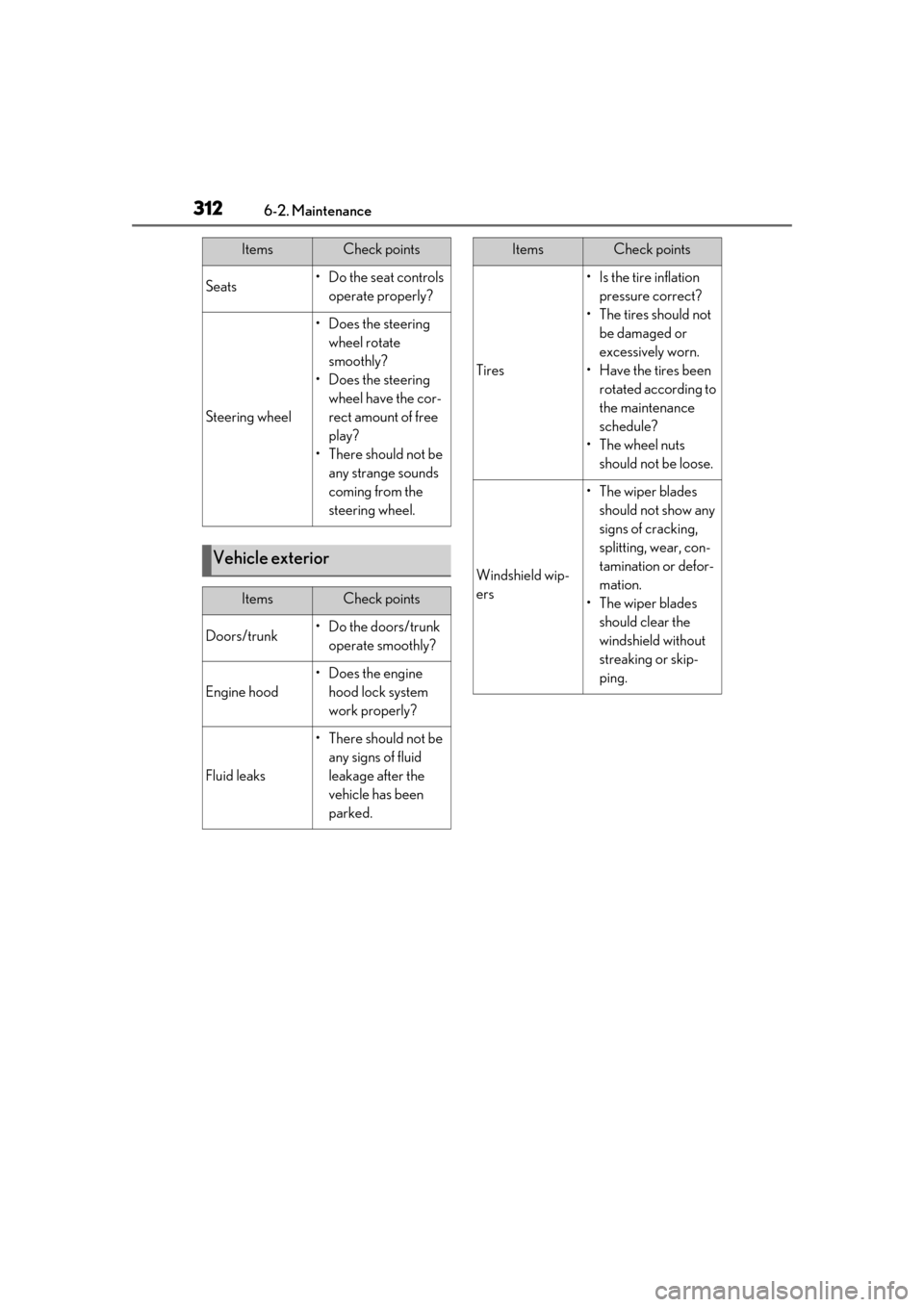
3126-2. Maintenance
SeatsέΑλ Do the seat controls operate properly?
Steering wheel
έΑλ Does the steering wheel rotate
smoothly?
έΑλ Does the steering wheel have the cor-
rect amount of free
play?
έΑλThere should not be any strange sounds
coming from the
steering wheel.
Vehicle exterior
ItemsCheck points
Doors/trunkέΑλ Do the doors/trunk operate smoothly?
Engine hood
έΑλDoes the engine hood lock system
work properly?
Fluid leaks
έΑλThere should not be any signs of fluid
leakage after the
vehicle has been
parked.
ItemsCheck points
Tires
έΑλ Is the tire inflation pressure correct?
έΑλ The tires should not be damaged or
excessively worn.
έΑλ Have the tires been rotated according to
the maintenance
schedule?
έΑλ The wheel nuts should not be loose.
Windshield wip-
ers
έΑλ The wiper blades should not show any
signs of cracking,
splitting, wear, con-
tamination or defor-
mation.
έΑλ The wiper blades should clear the
windshield without
streaking or skip-
ping.
ItemsCheck points
Page 315 of 456
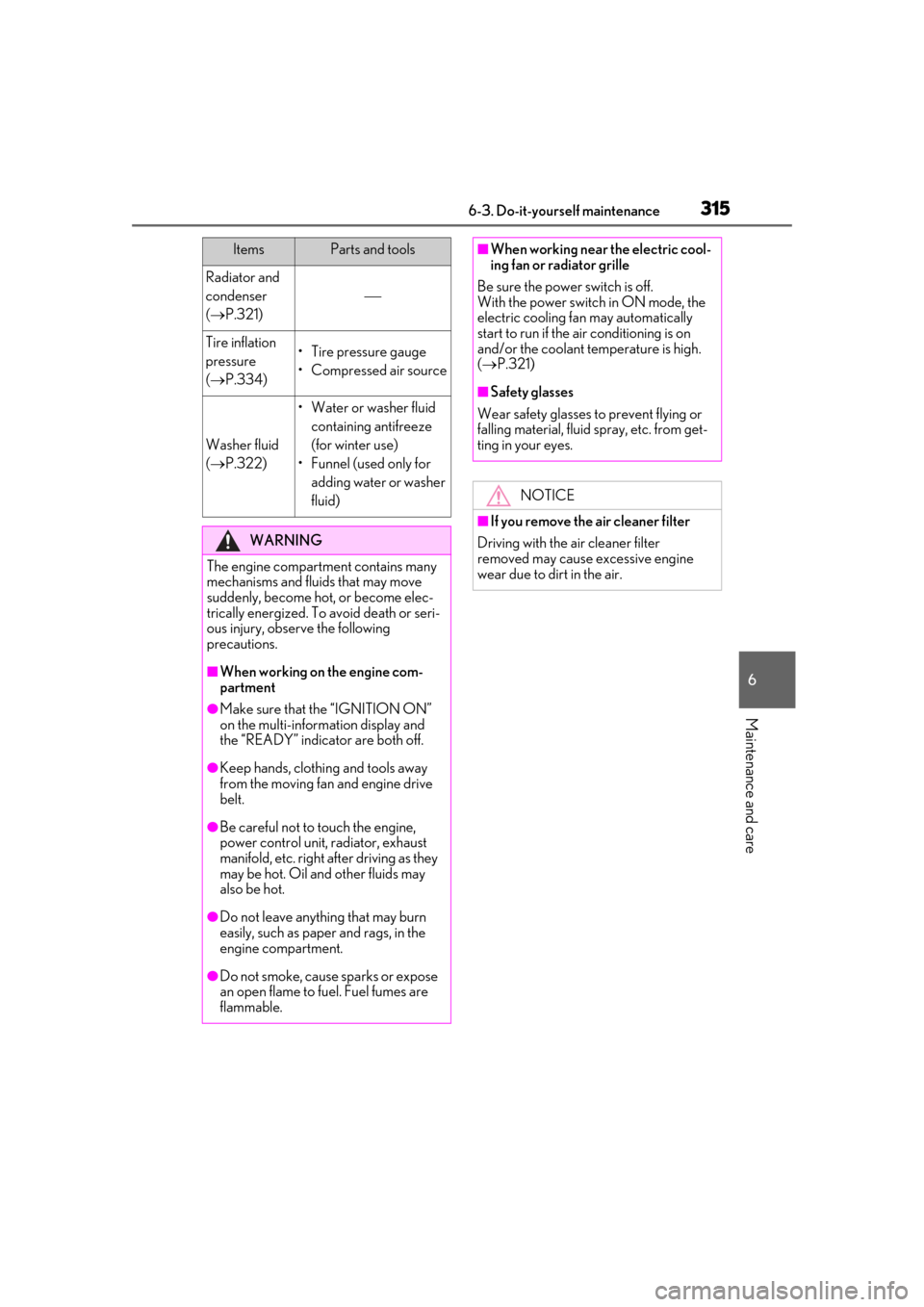
3156-3. Do-it-yourself maintenance
6
Maintenance and care
Radiator and
condenser
(ΎΓχ P.321)
ΎΓ╛
Tire inflation
pressure
(ΎΓχ P.334)έΑλ Tire pressure gauge
έΑλ Compressed air source
Washer fluid
(ΎΓχ P.322)
έΑλ Water or washer fluid
containing antifreeze
(for winter use)
έΑλ Funnel (used only for adding water or washer
fluid)
WARNING
The engine compartment contains many
mechanisms and fluids that may move
suddenly, become hot, or become elec-
trically energized. To avoid death or seri-
ous injury, observe the following
precautions.
έΨιWhen working on the engine com-
partment
έΩΠMake sure that the έΑεIGNITION ONέΑζ
on the multi-information display and
the έΑεREADYέΑζ indicator are both off.
έΩΠKeep hands, clothi ng and tools away
from the moving fan and engine drive
belt.
έΩΠBe careful not to touch the engine,
power control unit, radiator, exhaust
manifold, etc. right after driving as they
may be hot. Oil and other fluids may
also be hot.
έΩΠDo not leave anything that may burn
easily, such as paper and rags, in the
engine compartment.
έΩΠDo not smoke, cause sparks or expose
an open flame to fuel. Fuel fumes are
flammable.
ItemsParts and toolsέΨιWhen working near the electric cool-
ing fan or radiator grille
Be sure the power switch is off.
With the power switch in ON mode, the
electric cooling fan may automatically
start to run if the air conditioning is on
and/or the coolant temperature is high.
( ΎΓχ P.321)
έΨιSafety glasses
Wear safety glasses to prevent flying or
falling material, fluid spray, etc. from get-
ting in your eyes.
NOTICE
έΨιIf you remove the air cleaner filter
Driving with the air cleaner filter
removed may cause excessive engine
wear due to dirt in the air.
Page 326 of 456
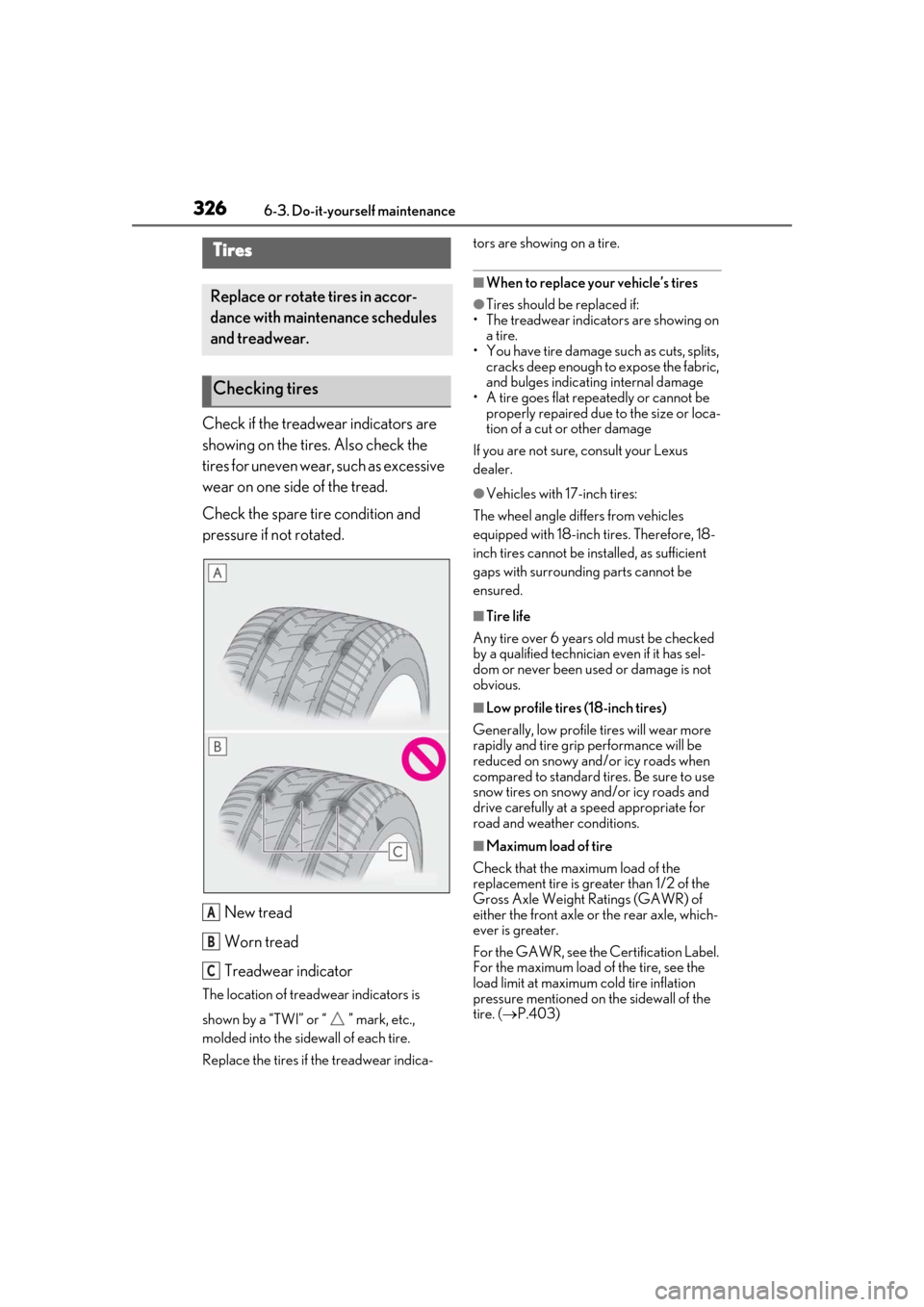
3266-3. Do-it-yourself maintenance
Check if the treadwear indicators are
showing on the tires. Also check the
tires for uneven wear, such as excessive
wear on one side of the tread.
Check the spare tire condition and
pressure if not rotated.New tread
Worn tread
Treadwear indicator
The location of treadwear indicators is
shown by a έΑεTWIέΑζ or έΑε έΑζ mark, etc.,
molded into the sidewall of each tire.
Replace the tires if the treadwear indica- tors are showing on a tire.
έΨιWhen to replace your vehicleέΑβs tires
έΩΠTires should be replaced if:
έΑλ The treadwear indicators are showing on a tire.
έΑλ You have tire damage such as cuts, splits,
cracks deep enough to expose the fabric,
and bulges indicating internal damage
έΑλ A tire goes flat repeatedly or cannot be
properly repaired due to the size or loca-
tion of a cut or other damage
If you are not sure, consult your Lexus
dealer.
έΩΠVehicles with 17-inch tires:
The wheel angle differs from vehicles
equipped with 18-inch tires. Therefore, 18-
inch tires cannot be installed, as sufficient
gaps with surrounding parts cannot be
ensured.
έΨιTire life
Any tire over 6 years old must be checked
by a qualified technician even if it has sel-
dom or never been used or damage is not
obvious.
έΨιLow profile tires (18-inch tires)
Generally, low profile tires will wear more
rapidly and tire grip performance will be
reduced on snowy and/or icy roads when
compared to standard tires. Be sure to use
snow tires on snowy and/or icy roads and
drive carefully at a speed appropriate for
road and weather conditions.
έΨιMaximum load of tire
Check that the maximum load of the
replacement tire is greater than 1/2 of the
Gross Axle Weight Ratings (GAWR) of
either the front axle or the rear axle, which-
ever is greater.
For the GAWR, see the Certification Label.
For the maximum load of the tire, see the
load limit at maximum cold tire inflation
pressure mentioned on the sidewall of the
tire. ( ΎΓχP.403)
Tires
Replace or rotate tires in accor-
dance with maintenance schedules
and treadwear.
Checking tires
A
B
C
Page 327 of 456
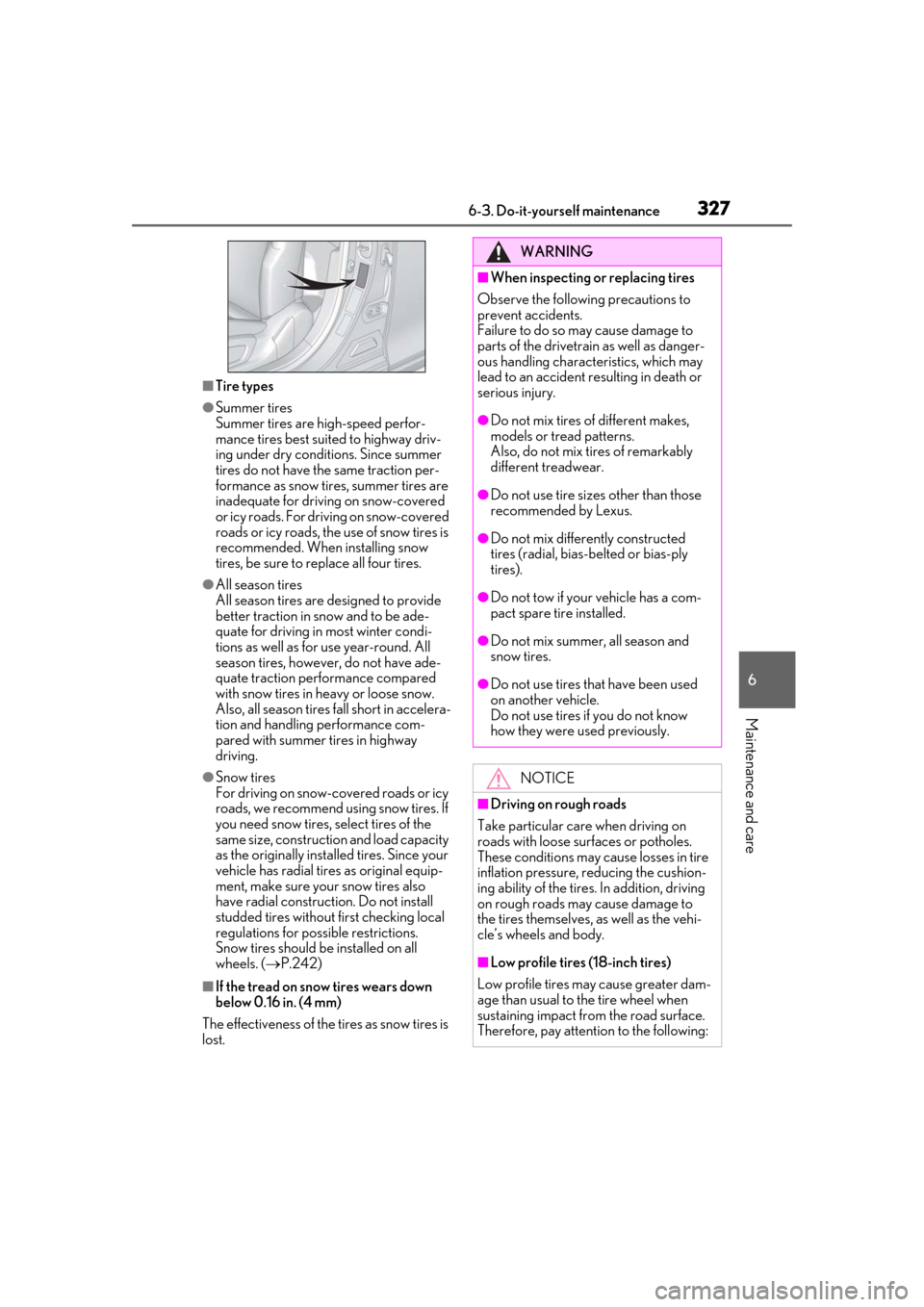
3276-3. Do-it-yourself maintenance
6
Maintenance and care
έΨιTire types
έΩΠSummer tires
Summer tires are high-speed perfor-
mance tires best suited to highway driv-
ing under dry conditions. Since summer
tires do not have the same traction per-
formance as snow tires, summer tires are
inadequate for driving on snow-covered
or icy roads. For driving on snow-covered
roads or icy roads, the use of snow tires is
recommended. When installing snow
tires, be sure to replace all four tires.
έΩΠAll season tires
All season tires are designed to provide
better traction in snow and to be ade-
quate for driving in most winter condi-
tions as well as for use year-round. All
season tires, however, do not have ade-
quate traction performance compared
with snow tires in heavy or loose snow.
Also, all season tires fall short in accelera-
tion and handling performance com-
pared with summer tires in highway
driving.
έΩΠSnow tires
For driving on snow-covered roads or icy
roads, we recommend using snow tires. If
you need snow tires, select tires of the
same size, construction and load capacity
as the originally installed tires. Since your
vehicle has radial tires as original equip-
ment, make sure your snow tires also
have radial construction. Do not install
studded tires without first checking local
regulations for possible restrictions.
Snow tires should be installed on all
wheels. ( ΎΓχP.242)
έΨιIf the tread on snow tires wears down
below 0.16 in. (4 mm)
The effectiveness of the tires as snow tires is
lost.
WARNING
έΨιWhen inspecting or replacing tires
Observe the following precautions to
prevent accidents.
Failure to do so may cause damage to
parts of the drivetrain as well as danger-
ous handling characteristics, which may
lead to an accident resulting in death or
serious injury.
έΩΠDo not mix tires of different makes,
models or tread patterns.
Also, do not mix tires of remarkably
different treadwear.
έΩΠDo not use tire sizes other than those
recommended by Lexus.
έΩΠDo not mix differently constructed
tires (radial, bias-belted or bias-ply
tires).
έΩΠDo not tow if your vehicle has a com-
pact spare tire installed.
έΩΠDo not mix summer, all season and
snow tires.
έΩΠDo not use tires that have been used
on another vehicle.
Do not use tires if you do not know
how they were used previously.
NOTICE
έΨιDriving on rough roads
Take particular care when driving on
roads with loose surfaces or potholes.
These conditions may cause losses in tire
inflation pressure, reducing the cushion-
ing ability of the tires. In addition, driving
on rough roads may cause damage to
the tires themselves, as well as the vehi-
cleέΑβs wheels and body.
έΨιLow profile tires (18-inch tires)
Low profile tires may cause greater dam-
age than usual to the tire wheel when
sustaining impact from the road surface.
Therefore, pay attention to the following:
Page 328 of 456
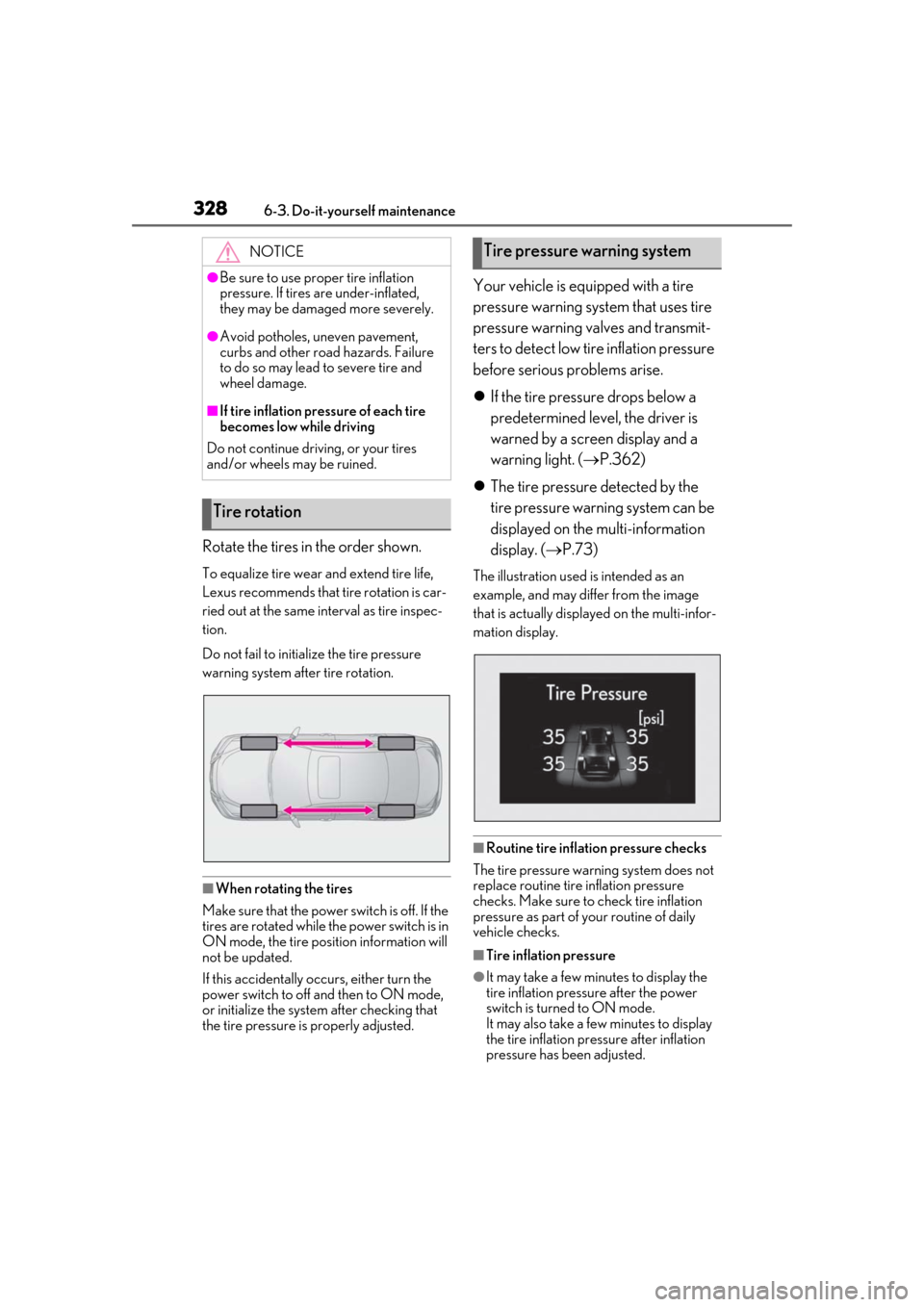
3286-3. Do-it-yourself maintenance
Rotate the tires in the order shown.
To equalize tire wear and extend tire life,
Lexus recommends that tire rotation is car-
ried out at the same interval as tire inspec-
tion.
Do not fail to initialize the tire pressure
warning system after tire rotation.
έΨιWhen rotating the tires
Make sure that the power switch is off. If the
tires are rotated while the power switch is in
ON mode, the tire position information will
not be updated.
If this accidentally oc curs, either turn the
power switch to off and then to ON mode,
or initialize the system after checking that
the tire pressure is properly adjusted.
Your vehicle is equipped with a tire
pressure warning system that uses tire
pressure warning valves and transmit-
ters to detect low ti re inflation pressure
before serious problems arise.
ΎΒυ If the tire pressure drops below a
predetermined level, the driver is
warned by a screen display and a
warning light. (ΎΓχ P.362)
ΎΒυ The tire pressure detected by the
tire pressure warning system can be
displayed on the multi-information
display. ( ΎΓχP.73)
The illustration used is intended as an
example, and may differ from the image
that is actually displayed on the multi-infor-
mation display.
έΨιRoutine tire inflation pressure checks
The tire pressure warning system does not
replace routine tire inflation pressure
checks. Make sure to check tire inflation
pressure as part of your routine of daily
vehicle checks.
έΨιTire inflation pressure
έΩΠIt may take a few minutes to display the
tire inflation pressure after the power
switch is turned to ON mode.
It may also take a few minutes to display
the tire inflation pre ssure after inflation
pressure has been adjusted.
NOTICE
έΩΠBe sure to use proper tire inflation
pressure. If tires are under-inflated,
they may be damaged more severely.
έΩΠAvoid potholes, uneven pavement,
curbs and other road hazards. Failure
to do so may lead to severe tire and
wheel damage.
έΨιIf tire inflation pres
sure of each tire
becomes low while driving
Do not continue driving, or your tires
and/or wheels may be ruined.
Tire rotation
Tire pressure warning system
Page 329 of 456
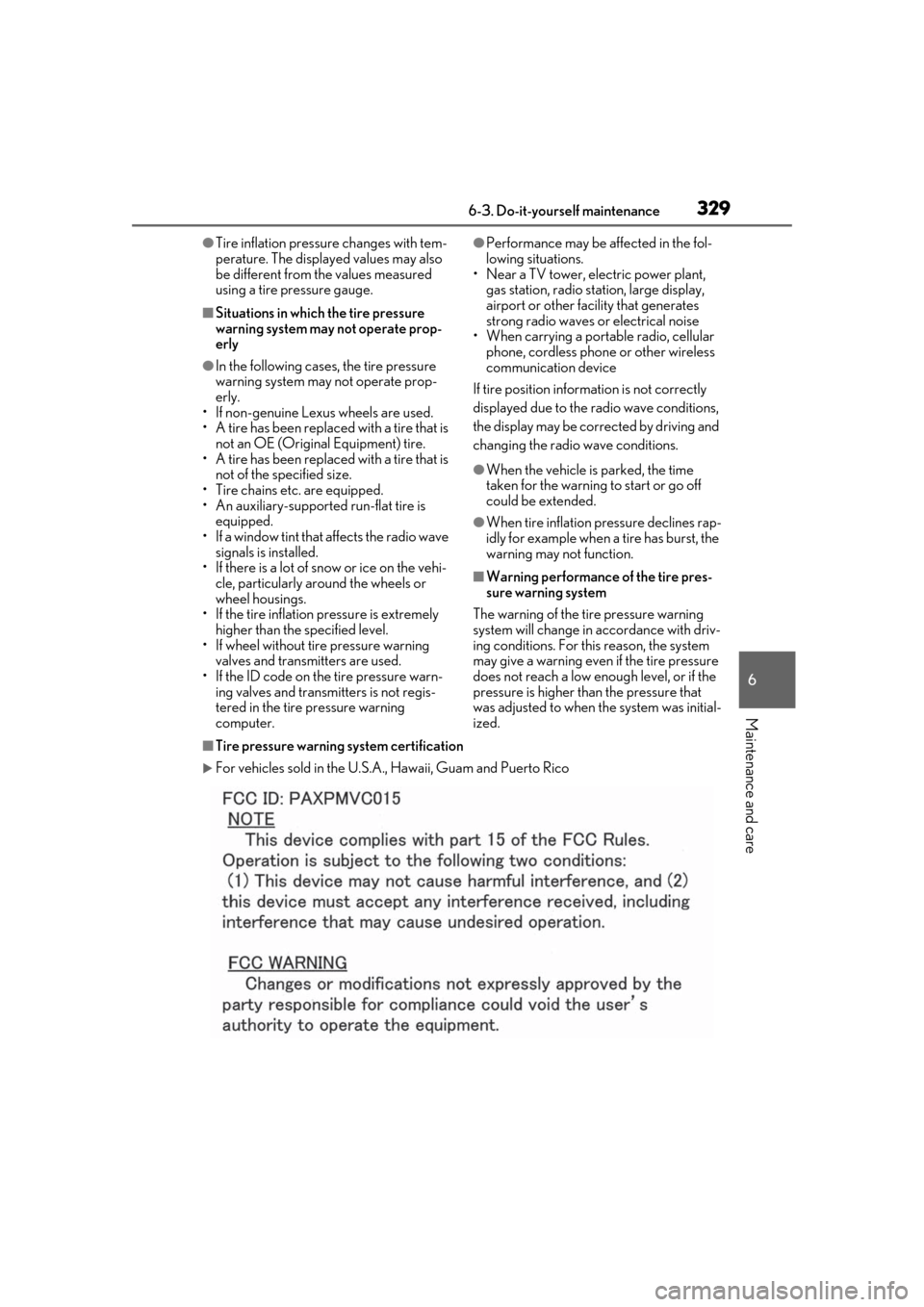
3296-3. Do-it-yourself maintenance
6
Maintenance and care
έΩΠTire inflation pressure changes with tem-
perature. The displayed values may also
be different from the values measured
using a tire pressure gauge.
έΨιSituations in which the tire pressure
warning system may not operate prop-
erly
έΩΠIn the following cases, the tire pressure
warning system may not operate prop-
erly.
έΑλ If non-genuine Lexus wheels are used.
έΑλ A tire has been replaced with a tire that is
not an OE (Original Equipment) tire.
έΑλ A tire has been replaced with a tire that is
not of the specified size.
έΑλ Tire chains etc. are equipped.
έΑλ An auxiliary-supported run-flat tire is equipped.
έΑλ If a window tint that affects the radio wave signals is installed.
έΑλ If there is a lot of snow or ice on the vehi-
cle, particularly around the wheels or
wheel housings.
έΑλ If the tire inflation pressure is extremely
higher than the specified level.
έΑλ If wheel without tire pressure warning valves and transmitters are used.
έΑλ If the ID code on the tire pressure warn- ing valves and transmitters is not regis-
tered in the tire pressure warning
computer.
έΩΠPerformance may be af fected in the fol-
lowing situations.
έΑλ Near a TV tower, electric power plant,
gas station, radio stat ion, large display,
airport or other fac ility that generates
strong radio waves or electrical noise
έΑλ When carrying a portable radio, cellular phone, cordless phone or other wireless
communication device
If tire position information is not correctly
displayed due to the radio wave conditions,
the display may be corrected by driving and
changing the radio wave conditions.
έΩΠWhen the vehicle is parked, the time
taken for the warning to start or go off
could be extended.
έΩΠWhen tire inflation pr essure declines rap-
idly for example when a tire has burst, the
warning may not function.
έΨιWarning performance of the tire pres-
sure warning system
The warning of the tire pressure warning
system will change in accordance with driv-
ing conditions. For this reason, the system
may give a warning even if the tire pressure
does not reach a low enough level, or if the
pressure is higher than the pressure that
was adjusted to when the system was initial-
ized.
έΨιTire pressure warning system certification
ΎΒ╡For vehicles sold in the U.S.A. , Hawaii, Guam and Puerto Rico
Page 330 of 456
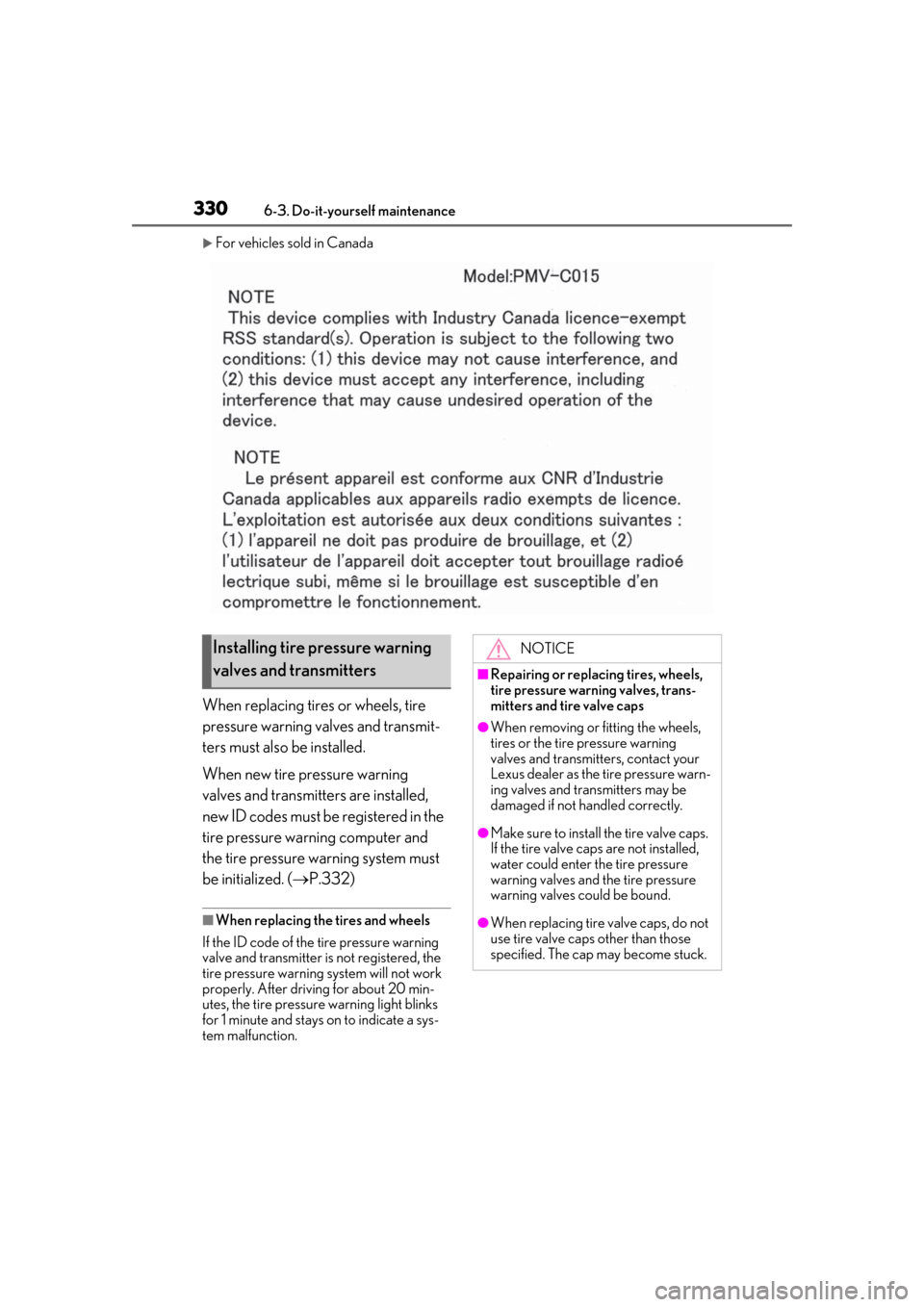
3306-3. Do-it-yourself maintenance
ΎΒ╡For vehicles sold in Canada
When replacing tires or wheels, tire
pressure warning valves and transmit-
ters must also be installed.
When new tire pressure warning
valves and transmitters are installed,
new ID codes must be registered in the
tire pressure warning computer and
the tire pressure warning system must
be initialized. ( ΎΓχP.332)
έΨιWhen replacing the tires and wheels
If the ID code of the tire pressure warning
valve and transmitter is not registered, the
tire pressure warning system will not work
properly. After driving for about 20 min-
utes, the tire pressure warning light blinks
for 1 minute and stays on to indicate a sys-
tem malfunction.
Installing tire pressure warning
valves and transmittersNOTICE
έΨιRepairing or replac ing tires, wheels,
tire pressure warning valves, trans-
mitters and tire valve caps
έΩΠWhen removing or fitting the wheels,
tires or the tire pressure warning
valves and transmitters, contact your
Lexus dealer as the tire pressure warn-
ing valves and transmitters may be
damaged if not handled correctly.
έΩΠMake sure to install the tire valve caps.
If the tire valve caps are not installed,
water could enter the tire pressure
warning valves and the tire pressure
warning valves could be bound.
έΩΠWhen replacing tire valve caps, do not
use tire valve caps other than those
specified. The cap may become stuck.